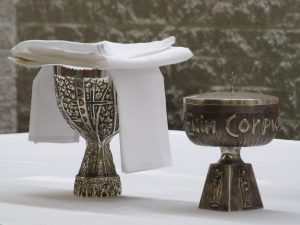“We are blessed to touch the linens stained with the blood of Christ, and privileged to prepare them for the next celebration of the Mass.”

The purpose of the Altar Linens ministry is to serve the community of Saint Gregory the Great by collecting, washing, ironing, and returning the linens used during Mass. The linens are laundered in a manner respectful of the body and blood of Christ that lingers upon these linens. Team members participate in a simple weekly rotation.
Contact: Maria Quitugua • 858-663-4135 • quitug8@aol.com
Below is a brief description of the different cloths used and how they are used as part of the Liturgy.
Altar Cloths
Just as the altar is a sign for us of Christ the living stone, altar cloths are used “out of reverence for the celebration of the memorial of the Lord and the banquet that gives us His body and blood. By their beauty and form they add to the dignity of the altar in much the same way that vestments solemnly ornament the priests and sacred ministers. Such cloths also serve a practical purpose, however, in absorbing whatever may be spilled of the Precious Blood or other sacramental elements. Thus the material of altar cloths should be absorbent and easily laundered. Care should be taken that proper cleaning methods are used to preserve the beauty and life of the altar cloth. It is appropriate for those who care for sacred vessels, cloths and other instruments of the liturgy to accompany their work with prayer.
Corporals
Sacred vessels containing the Body and Blood of the Lord are always placed on top of a corporal. A corporal is spread by the Deacon or another Minister in the course of the preparation of the gifts and the altar. When Concelebrants receive the Eucharist from the altar, a corporal is placed beneath all chalices or patens. Finally, it is appropriate that a corporal be used on a side table, and placed beneath the sacred vessels which have been left to be purified after Mass. When corporals are cleansed they should first be rinsed in a sacrarium and only afterwards washed with laundry soaps in the customary manner. Corporals should be ironed in such a way that their distinctive manner of folding helps to contain whatever small particles of the consecrated host may remain at the conclusion of the Eucharistic celebration.
Purificators
Purificators are customarily brought to the altar with chalices and are used to wipe the Precious Blood from the lip of the chalice and to purify sacred vessels. They should be white in color. Whenever the Precious Blood is distributed from the chalice, poured into ancillary vessels or even accidentally spilled, purificators should be used to absorb the spill. The material of purificators should be absorbent and easily laundered. Because of their function, purificators regularly become stained with the Precious Blood. It is, therefore, essential that they should first be cleansed in a sacrarium and only afterwards washed with laundry soaps in the customary manner. Purificators should be ironed in such a way that they may be easily used for the wiping of the lip of the chalice.
Lavabo Towels
The Order of Mass calls for the washing of the hands (lavabo) of the Priest celebrant in the course of the preparation of the gifts and the altar. Since it is his hands and not only his fingers (as in the former Order of Mass) which are washed at the lavabo, the lavabo towel should be of adequate size and sufficiently absorbent for drying his hands.
Other Cloths
Other cloths may also be used at Mass. A pall may be used to cover the chalice at Mass in order to protect the Precious Blood from insects or other foreign objects. In order that palls may be kept immaculately clean they should be made with removable covers of a worthy material which may be easily washed in the sacrarium and then laundered.
Disposal of Worn Altar Linens
Consistent with the disposal of all things blessed for use in the liturgy, it is appropriate that altar linens, which show signs of wear and can no longer be used, should normally be disposed of either by burial or burning.
Based upon the USCCB Committee on Divine Worship Newsletter March 2001


